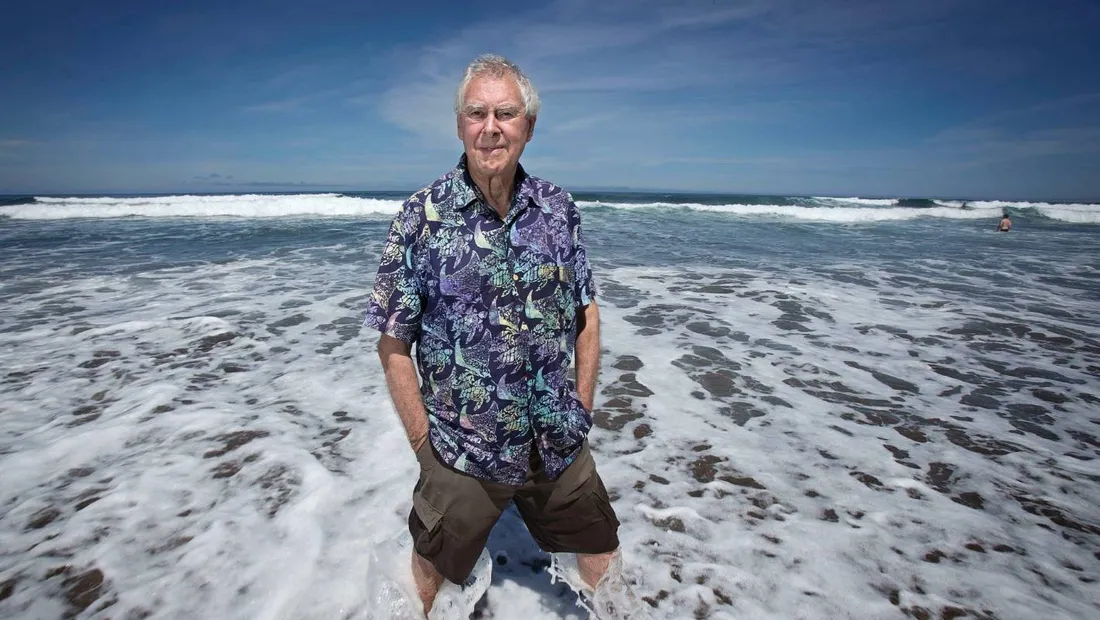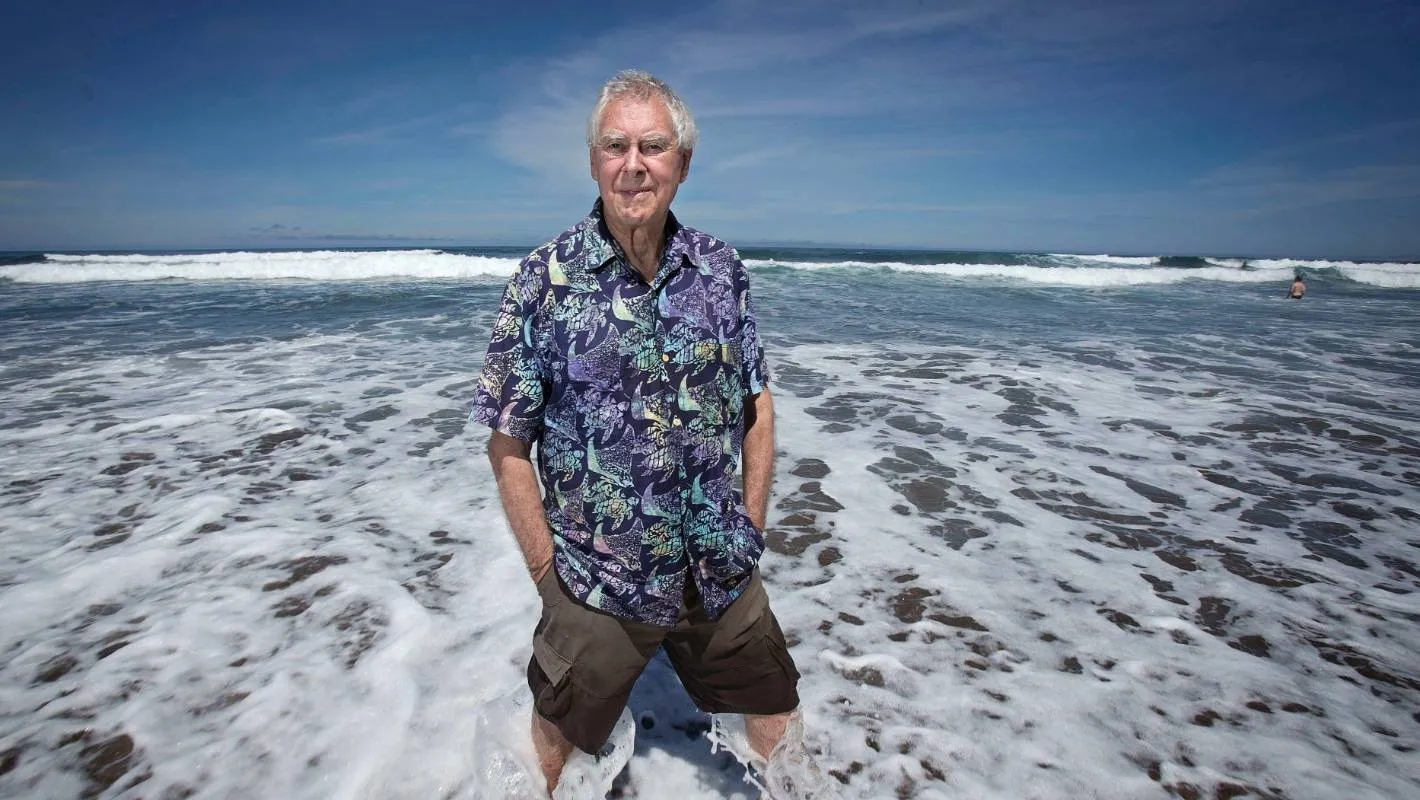Everyone loves Bob


Sir Bob has a warm place in my childhood memories of growing up in Titirangi in the 1970s and 80s as he mixed in the same social circles as my parents. Then he was an advertising man having started his own ad agency when he was 22 years old. On into the 90s when he became Mayor of Waitakere City he had the foresight to drive the West’s renaissance and transformation to an ‘Eco City’.
A socialist, greenie and former president of the Labour party, Bob is always gracious, down to earth and in true Westie spirit has time for everyone, including those who’ve had less opportunities than himself.
When we began the interview he remembered meeting me at a dinner party in the early 2000s hosted by our mutual friend, LA based TV Producer Gus Roxburgh.
“Didn’t you survive a shark attack?” he asks me. (I did, in Vanuatu in 1992). That led us to discussing his legendary ocean swim across the Manukau Heads from the southern tip to Whatipu - a tale I’d not heard before. He swam with two of his Karekare Surf Club mates after two years of planning – the threesome are still the only men to have ever achieved this feat.
“I remember seeing the sharks whizzing around me, it was the most amazingly treacherous swim, I saw so many large sharks underneath me swimming at horrific speeds about six or seven metres down below us,” he said.
One of Bob’s proudest achievements was saving the Waitakere Ranges from sub-division during his 18-year tenure as mayor of Waitakere City, 1992 -2010. I, and many of my contemporaries, am grateful for his love of this place he calls home.
I am on the waterfront talking with Bob about his new book Sea Edge published by Oratia Books, about his passion for McCahon (see below for his role in the centenary celebration) and fishing for his typically pragmatic tips for aspiring writers. But at this point, I must confess that I find myself totally beguiled by the mastery of this storyteller. Already I am spellbound by the pace and number of his stories, including a swim across the Dardanelles that he throws in for good measure. It’s clear that his life is one lived to the full and one that can only inspire the listener or reader.
A humble beginning
Sanford’s fish yard, Auckland, October 1905. Sir George Grey Special Collections, Auckland Libraries.
Bob’s adoptive father was a fisherman with Sanfords and one of his earliest memories is of catching a tram down Queen Street with his mother from their Grafton gully home to meet his father’s fishing trawler at the waterfront. There the catch would be spread out on the wharves and the smell from the great fish smokers was mixed with the salty sea air.
This story is one of many told in Sea Edge, a deluxe hardback book which features stunning art and photos, and insightful text that is the culmination of years of intensive research into the history and photo archives of Auckland. The book is a collection of old and new stories, vignettes of the past and visions of the future, accompanied by many previously unpublished photographs and illustrations.
The power of the narrative is the transformation of the Auckland Waterfront across history – including the enormous task of reclamation, building the port and developing commerce and culture. Since Polynesian voyagers first made landfall in their double-hulled sailing canoes, new arrivals have continually rediscovered and redefined the harbour and Hauraki Gulf.
Bob recalls it was when he began the role as chairman of Waterfront Auckland that he fell in love with the harbour all over again and it was around this time he came up with the idea for the book. “The harbour and I are great friends. I always gravitated to those harbour beaches, I learnt to swim at the Tepid Baths and loved swimming at the Shelly Beach Baths” (these were lost when the Harbour Bridge went in - another story that’s told in the book).
Deadwood (now Ponsonby) and Franklin Rd
There are so many wonderful tales in the book he enthuses, there’s the Russian scare that led to all the guns being built on North Head. There are the brothers who built Bean Rock and Lady Franklin who sat in the sun at Freeman’s Bay, which is at the bottom of Franklin Road.
He’s loved discovering Mrs Franklin. Her husband was an adventurer who was lost during an expedition to find the North-West Passage. It was while he was on that fateful expedition that Captain Hobson invited Mrs Franklin and her children to visit New Zealand, as they were family friends.
“She rode all around Deadwood (which was the original Ponsonby) on horseback and there’s still a Deadwood Terrace in Ponsonby and because she used to sit in the sun at Freeman’s Bay, Franklin Road which went up the hill above the bay was named after her.”
Other favourite personalities he came to know during the writing of the book include Captain d’Urville and also Samuel Marsden.
Structure of the story
Sea Edge is organised into four sections:
The Beginning: from Maori on the Waitemata and Governor Hobson through to Shed 10, the Auckland Ferry Building and Henry Winkelmann
The Inner Harbour: America’s Cup and yachting heroes, Sanfords and fishing, on to today’s developments including the new Park Hyatt and GridAKL
The Working Waterfront: work including scows, Devonport Naval Base, The Great White Fleet, waterfront strikes, SkyPath and Wynyard Point
The Future of the Waitemata: plans and dreams for a sustainable waterfront
As we walked through the parts of the book he told me that he discovered a proposal to build a canal between the Waitemata and Manukau Harbour that never eventuated. One of the options is pictured below.
This map shows the proposed canal connection between the Waitematā and Manukau harbours, c.1903.Sir George Grey Special Collections, Auckland Libraries, NZ Map 6231
Future of our sea edge
Archimedia gives the harbour a twenty-first century solution, a starting point for new dreams and a vision of the future from young architects, planners and designers.
“We owe it to our descendants to acknowledge our past and face the future of our sea edge with respect and consideration of what we could lose,” Bob says in the book’s introduction.
“Thanks to the protest groups we will see no more damage to the Waitemata harbour, no more filling in and stupid things like the mooring dolphins – my message is stop the bad behaviour now … and protect our harbour for generations to come.”
How Bob shifted from Ad Man to Storyteller
His first foray into storytelling began when he started writing for Metro Magazine thanks to his “wonderful friend Warwick Roger’ who started the magazine and who gave Bob the opportunity to write for Metro ... “and so I wrote for the magazine from the second issue as a contributor for many years.”
His first book was about bringing up children (he and wife Barbara raised five children), the book was entitled Hey Dad and Tom Scott did the illustrations.
“Storytelling and writing came naturally because I was a copywriter and after writing articles, I saw the book as an extension of the writing I was doing”.
His next book was Rolling Thunder – The Spirit of Karekare, it was his homage to Karekare and the west coast of Auckland.
His passion for Auckland’s west coast beaches is well-known and the subject of more than one his books and Bob remains an active patroller and life member of Karekare Surf Club having joined the club at age 15.
Art of selling a story
Getting stories funded is also a talent that Bob has mastered.
“To sell this story I treated the book as a movie, I saw the idea, I saw the concept, I saw the story although I must admit it got bigger and bigger and overtook me.” he says.
He was sponsored to write Sea Edge by Fu Wah International Group, who are developing the new Park Hyatt Auckland due to open later this year. The new hotel is located on the water’s edge and will have expansive views across Wynyard Quarter - which Bob helped create as chair of Waterfront Auckland.
“That’s New Zealand, you can be brought up as the son of a fisherman and go on to lead a new vision for the city’s waterfront,” he says.
Simple Advice
I asked Bob what advice he would give to aspiring writers. His advice was simple.
“Just start doing it. Don’t procrastinate. Get a piece of paper in front of you and write the first sentence! Don’t put off your life saying you’re going to write something, bloody well do it. But once you do it, be committed to it. Write every day of your life.”
“When I am writing a book sometimes I will start dictating when I am swimming or when I am in bed. I dictate in my mind … so as soon as I start writing, and I write a lot in longhand at the beach, the words just flow, because I have often already dictated it to myself. You develop this ability over time and you just need to write one sentence to get started,” he says.
“I am currently writing a book about the West Coast and I thought how do I start?” Then I met a monk at a dinner party and I told him I was trying to write a book. He said, “What do you need to ask me? I said, How do I write this book about the West Coast? He said, “The sea is the blood of god.” I took his hand and kissed it. I didn’t say anything but thank you, because I knew he’d given me the first line of a 400 or 500-page book that will be the biggest book I ever write.”
A chance to hear the master storyteller
Sir Bob Harvey’s talents as a narrator and a storyteller are being celebrated in two upcoming events.
He will be speaking about his new book Sea Edge at the Going West Writers Festival on Saturday, 7 September 2019 9:00 am - 10:00 am Titirangi War Memorial Hall. If you want to go along book at goingwestfest.co.nz
As part of the Colin McCahon Centenary celebrations over the weekend of 17-18 August, Bob will be one of two narrators on a special bus tour between Auckland Art Gallery and McCahon House. This replicates the same commute McCahon himself took while working at Auckland City Art Gallery and living at French Bay, Titirangi. The bus commute had a direct impact on McCahon’s art. Among other works gestated on the bus, his series Towards Auckland was inspired by the view of Auckland from Titirangi Road. The return journey led to the Manukau works, which developed over several years. Onboard the bus trip will be one of two guides.To find out more about this and other events at McCahon House which celebrate the centenary check out McCahon House website.